UF || English literature & linguisticsOwl enthusiast and enjoyer of a great many teas...JPT1311 blog
Don't wanna be here? Send us removal request.
Text
Xenoblade Chronicles and the Environment
Perhaps it is because I have simply been thinking too much about my final paper, but Xenoblade Chronicles reminded me of the way that Castle in the Sky (my chosen analysis piece) also handles the relationship between the environment and humanity. Well, in actuality, I find these pieces of media to be profoundly contrastive. While Castle in the Sky advocates against humanity’s intervention with nature, Xenoblade Chronicles depends upon it. This difference presents two surprisingly contradictory solutions to environmentalism that I would like to dissect a bit more.

I will begin with Castle in the Sky—this film features a similar mythological paradise or utopia that is framed in an analogous way to Elysium in Xenoblade. In either piece, these utopias are often even rejected by the public, simply written off as fiction—children's stories. But there are people who seem to believe in their existence, even being certain that they are real—and of course, they turn out to be correct. However, after discovering these utopias, there is a realization that these places are now abandoned, only mere shells of what they once were.


However, in Xenoblade Chronicles, we are fed the idea that humanity must play an integral part in mending, not only the utopia, but the environment that surrounds it. This is the reason for the cycle of titans, to blades, to humans. They serve to create a kind of rebirth for the environment. In Castle in the Sky, our characters realize that they are only doing more harm by interacting with Laputa. Because of the immense power that Laputa holds, Laputa cannot be safely held in the hands of men any longer. Its rediscovery, along with its subsequent destruction, displays that in order to preserve the utopian environment of Laputa, humans must stay far, far away from it. That is the only way to allow it to flourish.
This connection between these two pieces of fiction really inspired some of my essay, so I hope that you found this interesting!

0 notes
Text
Worldbuilding in Nausicaa of the Valley
I must say, this movie absolutely enchanted me. My weaknesses include owls, bagels, and good worldbuilding—and gosh, was this just excellent! The setting of this movie was so inventive. I found myself lost in the intricate, alien world that was the Sea of Decay.
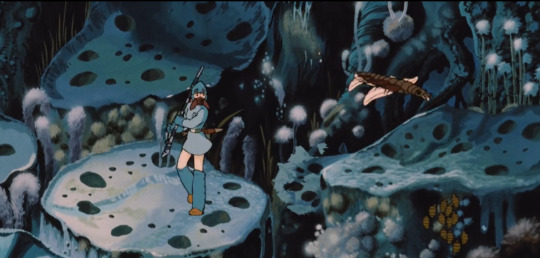
The Sea of Decay and the plants that live in it too are also clearly inspired by different types of fungi, which was compelling to me. I noticed that these fuzzy-tipped ones looked like aspergillus oryzae when under a microscope. I also thought the scene with the snowing spores was such a clever idea and added some wonderful atmosphere—immediately showing the viewer the beauty of the toxic sea, even considering its lethality.
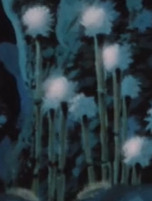

I think that at times too, the Sea of Decay often behaves like the ocean with its tranquil, silent landscapes and gently suspended bugs. Creatures move so smoothly that it seems like they could be underwater. I am sure that it took quite the effort to produce all the nuanced bug designs, but they did an excellent job.

And of course we Miyazaki cannot have a movie without including aircraft of some kind. Nausicaa’s glider is sleek and a lot of fun to watch animated. Because it is so thin, it has this really nimble quality to how it moves, which I very much enjoyed.

It is a personal thing too, but I have recently been enjoying post-apocalyptic/disaster world building. I think it is fascinating to brainstorm ways that humanity still survives against dangerous phenomena and finds a way grow along or in opposition with it. The politics that arise with it too—like the different kingdoms inhabiting this movie—provide an exceptional piece of social critique. When I described this movie to my brother after finishing it, I told him how I imagined Nausicaa’s world to have so many more stories. I think when a piece of media achieves that sense of scope, it has really done something phenomenal.

10/10
8 notes
·
View notes
Text
Comparing Shinji and Kirito - The figure of the self-insert
Character development

As I progressed through the assigned episodes, I found my mind often tracing back to Sword Art Online, lingering on the characterization of Kirito in contrast to Shinji. As main characters often go—at initial glance they look remarkably similar. Just about every Shonen anime’s protagonist must be designed with these ubiquitous traits: short, black hair, black eyes, fair skin, and a ‘lone wolf’ deportment. Why, they are crafted to exist as average, common, a mirror that reflects the viewer—for, they are the ever-pervasive self-insert.

But beyond appearance, Shinji does not hold the same courage, reliance, competence, and plot armor of his SAO counterpart. Shinji is exceptionally realistic and grapples with some serious trauma and expectations that he is never able to truly mend or achieve. Shinji is debilitated by his past suffering, he does not make his own decisions, he fails to get the girl, and he never escapes the desolate trench of his depression. Often, his actions to obtain these things result in an existential futility. He begins to push others away and in time, they stop reaching back to him. Shinji does not live in a world in which people revolve around him and this is nothing like the way Kirito is portrayed in SAO. He pushes others away, but somehow still ends up with people anyway. Opportunities happen upon him, and he is endowed with an immense adroitness in battle and political affairs. His trauma only serves as a plot device—they are the shadow of a backstory—and excuse to call him ‘developed.’

There is a barrenness to Shinji’s character. It never seems that he will get better. His hope is repeatedly dashed from him, and this results in a nuanced and dark character study that lingers in my mind for a long time.
Trauma truly has the potential for sweeping, inexorable corruption.

0 notes
Text
Malevolent Corporations in Sailor Moon

I wasn’t someone who was ever into Sailor Moon as a child, so being able to watch it was plenty of fun for me. I thought the art style and animation were just really pleasing to look at—the pastel palette of the show provides this feminine and youthful touch to all the scenes which I think pairs nicely with the themes this show prioritizes.
From the episodes that we watched I think it’s fair to say that each of them allegorically tackles problems that young girls face as they grow up. Usagi ceaselessly desires more than what she has—more expensive jewelry or a thinner frame—it is an unfortunate truth that these things are often prized in your girls’ lives. Usagi realizing the malice behind these material organizations represents a growing understanding that, while popular, material temptation often does more damage than good.

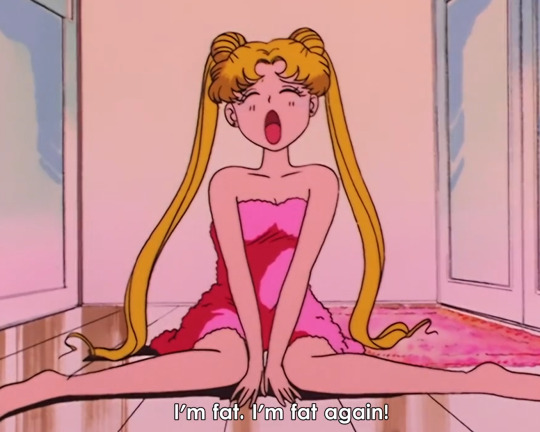
The image of the “evil cooperation” is prevalent here, as each of Usagi’s missions result in the dismantlement of some kind of preying organization. The villain, Queen Beryl, only ever seen hovering over her luminous crystal ball as she sends henchmen to do her bidding, reflects the workplace, with heads of large companies often sending those who work below them to follow through with (sometimes immoral) requests. This alone makes me curious about how the rest of the series executes this foundation.
I must say, as well, that the music in this anime is just so enjoyable. I found myself often bobbing my head every time Sailor Moon’s battle theme started playing. I loved the fusion between orchestral and modern rock/pop that soared over each of the fighting scenes. And I also recall a bit of a jazzy element peek through during more mundane moments of the show.

This series is really precious and I think there’s a good chance that I might watch more of it in the future. It reminds me of other lighthearted 'girl-power' shows I used to watch--like Mermaid Melody and My Little Pony. I can understand why it is such a nostalgic comfort for so many.
6/10
3 notes
·
View notes
Text
SwampCon 2024
Convention Post
Last semester on March 2nd, I had the pleasure of attending the annually held SwampCon at the Reitz Union (at the mercy of my dear friend Angel). It was one of the first anime conventions I had ever been to, so naturally I did not know what to expect beforehand. All that prefaced my experience were the confident assurances of my friend that I would, in fact, enjoy myself and my preconceived notions of convention culture based on video essays and social media. I knew there to be plenty of trinkets to peruse, so I had conceded the inevitability that my wallet would open at least a few times. I anticipated the Artist Alley most of all, where fan artists set up booths with stickers, prints, posters, keychains, and other memorabilia all themed around different anime and video games. In a bit I will post some pictures of the lovely things I purchased.
But our day began with a visit to the maid cafe. Upon entry, the Reitz ballroom was furnished with a cluster of tables, each draped with a tablecloth and set with glasses and napkins. People in maid costumes—as one might expect to see—stepped onto a stage lined with glittery plastic fringe to perform a few dances to popular anime openings. I had the delight to choose between various desserts—cookies, fruits, and brownies (I chose the brownie)—along with some lemonade.

Pictured: My friends and I waiting for the show to begin.
After that we went to the Artist Alley—and this was most definitely a lovely time. I went to find an artist I had seen on the schedule website named Anna Jano. I got two prints and an owl enamel pin (it really is such a lovely thing). I also came away with a single D20 die and a keychain of the character HERO from OMORI.




Pictured: Anna Jano prints, Anna Jano enamel pin, HERO keychain.
My friends surprised me with a SpyXFamily poster as well. How kind of them.

Pictured: My SpyXFamily poster hanging in my dorm room.
Beyond the Artist Alley, we also visited a room with booths displaying other wares such as jewelry, woodwork, stuffed animals, figurines, and toys. If I had the funds I would have invested in one of the wood-carved D&D polyhedral dice boxes. Oh goodness... a girl can dream.
By this time of day, the bustle of the day—and the weariness it induced—was beginning to come upon me. Conventions, it seems, can take a lot of energy out of you. Before our lunch break, however, we tuned in to the Five Nights at Freddy’s lore presentation. I must admit, I am not cultured enough to understand the nuances of the bite of '87. The only significant cultural information I can offer is a reference to that one clip of Markiplier. It was fun to see my friends enthusiastic about it, though.

Pictured: "Was that the bite of '87?"
After lunch, we returned to the convention and participated in an escape room. It was a ten-minute one that had a few puzzles to solve. We were placed in a group of around 15 people and were tasked with finding various items that culminated in a collective mental synthesis over a kind of riddle. Well—it may not have been a riddle. I don’t remember it all too clearly. But the good news is that we escaped—albeit with only a few seconds on the clock.

Pictured: Waiting in line before our endeavor at the SwampCon escape room.
Our last stop of the day was an event that my friend had threatened to take me to for months: Bad Fanfiction Reading (18+). Well... it is what it sounds like. Two hosts read to the vast audience of conventioneers while volunteers from the crowd reenacted the fanfics like a stage play. The (18+) part is important, as it was just as much vulgar as it was silly! Hah. Well it was an experience to say the least. I did have my fair share of giggles.

Pictured: Bad Fanfiction Reading opening slide.

Pictured: "Oh... how nervous we are to witness Bad Fanfiction Reading!"
We parted ways after that and I went home to hang up my newly acquired prints and rest!
This little reflection reminded me of all the fun I had with my friends. Conventions can be a very wonderful way to interact with others who share your interests. I will most certainly be attending next year.

Pictured: Heading home.
5 notes
·
View notes
Text
Genshiken
Part 2

Oh, we get to watch more of this... I am not enthused about it, but I have things to say.
I think episode 5 of Genshiken mirrors a similar recent phenomenon in fan culture—the pipeline from fanfiction to publication. This has happened more times than one might think! I remember reading the Mortal Instruments series by Cassandra Claire in middle school to later find out it was based on a previously written Harry Potter fanfiction. This ‘reskinning’ of fanfiction has more recent examples too, such as with the popular romance novel The Love Hypothesis being based on a Star Wars fanfic, and the After fanfics getting a series of movie adaptations. It is becoming all too common for publishers to seek out new material through unconventional means.
Is the manga that Chika created and printed similarly established from fanfiction? I would say so, as it is based on her romantic imaginations between her Genshiken peers. Her process towards self-publication follows many of the same beats that are taken in real-life circumstances.
I begin to think of the way that media consumption influences our creative endeavors. There have been plenty of times that I have written world-building ideas based on features of other pieces of fiction—gosh, even real life. I cannot count the times I have set down books just to jot down another idea for my D&D campaign or creative writing project. In this way, I can appreciate the commentary that this episode has over all else. Inspiration for fictional works can truly sprout from anywhere.
The question of ethics does often arise when thinking about fanfiction written about real people. Of course, it is extremely common, but is it right to subject someone to works of fiction about them without their consent? It must at least be... awkward if not damaging to the person’s real relationships and mental health. But there’s not much way that this could be regulated at all, even if someone tried.

1 note
·
View note
Text
Genshiken
Part One
Oh goodness, I did not like this one.
But—I suppose this anime does display the uglier parts of fandom culture. I was surprised to see just how much fandom/otaku culture depends on sexual content.
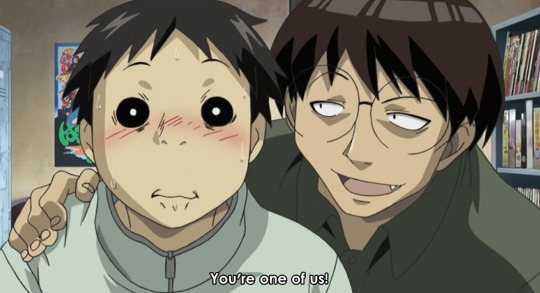
The members of Genshiken seem to initiate new people through this shared interest in sexual content. They bond over the embarrassment of such interests and form a community where they indulge in their hobbies without shame.
In just the third episode, we see just how pervasive otaku culture truly is... The club visits a convention held dedicated to the exchange of fan-made magazines which abound with characters drawn in compromising positions. I got the sense that many of those entrenched in otaku culture have found themselves social outcasts from normative society. With the omnipresent internet, subcultures have only increased in activity, reaching people from across the world. It makes it much easier for people to find others that they connect with.

“Anywhere you look here, we’re all the same.”
I certainly do not believe this anime portrays all aspects of fandom culture. Truly, fandom is a multifaceted notion that extends throughout history—one might even say as far as a religion has been practiced. The Jesus fandom is still rampant these days! (But seriously, did you know that there really is Bible fanfiction out there?)
I will not pretend I was not aware of this side of fan culture. I know now, after a two-hour long video essay, that My Little Pony: Friendship is Magic was not simply watched and enjoyed by 9-year-old girls (such as myself). In fact, episode three of Genshiken eerily sent my mind to pictures of the numerous My Little Pony conventions where, displayed in the artist markets, were absurdly erotic imaginings of the colorful unicorns and pegasi plastered upon body pillows and posters alike.
I would hate to be the disillusioned parent who innocently thought to bring their two young daughters to a My Little Pony event only to be met with explicit merchandise and a sea of grown men. Trip ruined.
2/10
0 notes
Text
Visual Metaphor in A Silent Voice
I wanted to list some recurring symbols that I noticed while watching this movie. A Silent Voice has some really excellent imagery that serves as a conduit for beautifully profound storytelling.


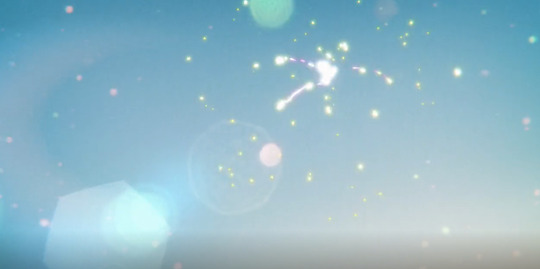
Both times that Shoya and Shouko nearly ended their lives, fireworks were present in the skies of the scenes. Fireworks can often be seen as representations of life, for they are short, bright, and impactful. The tonal contrast of celebratory fireworks and the dread of a life potentially lost illuminates the mistake that would have been made if either character went through with their actions. Considering this, fireworks can also symbolize the hope that life can change for the better.

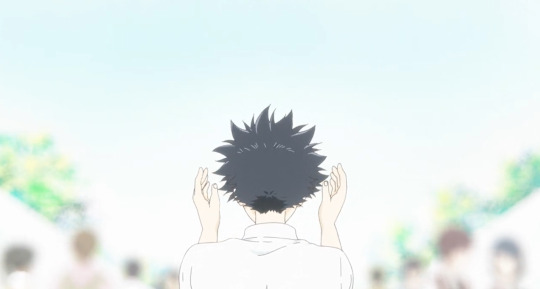

An especially prominent visual feature of this film is Shoya’s Xs over the faces of those he has shut out from his life. They signal his unwillingness to interact with others, stemming from his trauma and shame from elementary school. But as the film progresses, there are moments when Shoya oscillates between dropping the Xs and replacing them once more. These moments allow the audience to see precisely when Shoya begins to accept or reject people in his life.
The juxtaposition between the beginning of the film, where all that Shoya sees are Xs, and the end, where all of the Xs drop from peoples faces together, is a beautifully impactful scene that displays Shoya’s change in perspective towards his ability to connect with others.



Bridges are representative of the connections that we have with those around us. Shoya “burned” bridges with his classmates, even preventing himself from connecting with new people as well. The primary ‘bridge’ that Shoya works to rebuild is the one between him and Shouko, so throughout their relationship, we see them meet in the middle of a bridge that extends over a river of koi.
7/10
0 notes
Text
Motherhood
Wolf Children
“There's a point, around the age of twenty, when you have to choose whether to be like everybody else the rest of your life, or to make a virtue of your peculiarities.” - Ursula K. LeGuin

We are presented with choices that shape and reroute trajectories, but is it too often that personal decisions can be overwritten by those around us. Unsurprisingly, the figures who often impact our lives the most are our parents. They go from virtually supporting our survival as infants and slowly part from us as we grow older and self-sufficient. This process of letting go of entities who were once so closely dependent on us is a challenging thing to grapple with. Wolf Children studies this attachment, for motherhood is more than providing for your children. As a parent, one must often pour their existence into that of their children—their identity becomes who their offspring are. It is an act of selflessness that cannot be overlooked.
Motherhood is a paradoxical thing—for it is selflessness and selfishness, control and helplessness—these are inevitable facets of dependent relationships. In Wolf Children, we explore a remarkably accepting form of child-rearing. Hana, a resilient and selfless character, leaves her life of study for the good of her werewolf children by deciding to steer her family’s life into pastoral isolation. With her husband passing just after the birth of their second child, Hana is left alone with a responsibility she was not entirely prepared for. But she dedicates her life to learning about wolves and finds community and happiness through her efforts.

There is a duality present within a werewolf—man and wolf—society and nature—Hana’s children grow divergently, with one choosing to lead a life as a wolf and the other a human. This represents the child’s choice to grow up and become who they want to be. While challenging for Hana to let go of her parental control over her children’s lives, she learns to grant them the freedom to take hold of their lives independently.

I’ve watched this movie before and loved it when I did. I think its themes gave me a new perspective on motherhood and allowed me to view my own mother differently. It is easy to look past all of the important things my mom has done for me as a child, but really she was an invaluable part of my childhood. I really think the job of a mother can be tremendously overlooked by the world.
I could watch these werewolf children run through snowy forests forever.
10/10

2 notes
·
View notes
Text
Grave of the Fireflies
What do I even say? That was the most heart-wrenching movie I think I’ve ever seen in my lifetime. Fifteen minutes in and I shed my first tear. Halfway through, I can hardly focus on the screen through my crying. Then ten minutes before the end, I must pause the movie and sob for however long to try and compose myself so I can finish the rest of the film and do this assignment.
This movie has opened my eyes to so many things, that I am not even sure how to articulate it all.
The film was adapted from a semi-autobiographical short story by Akiyuki Nosaka. In his life too, he experienced the death of his two-year-old sister during WW2 and wrote the short story as an apology for not saving her life. I found it interesting to learn that this film was directed not by Hayao Miyazaki, but by Isao Takahata. It is obvious to me the difference in direction this film takes from other staple Ghibli works. Takahata reflects reality as authentically as possible, with no space for the signature whimsy that occupies much of the other Ghibli movies.
I was thinking about how long it has been since I’ve had such a raw reaction to a piece of media. Despite being a literature major, I don’t often find myself crying over novels. Even live-action films hardly get any comparable emotions to rise from within me. However, the medium of animation surpasses whatever barriers I have and breaks me down from the inside out. It might be the combination of music and visual art that speaks to me so much. I think there is so much that you can do with animation, really. The motif of the fireflies—how they glow like embers suspended over Setsuko and Seita’s heads—I can only imagine that animation can capture that feeling. It’s just so, so beautiful. So beautiful and so tragic.

10/10.
1 note
·
View note
Text
We Are Humans
Shinsekai Yori
This anime was actually based on a novel series by Yusuke Kishi and I am pretty set on reading it after this watch-through. I am craving the entirety of this series now; it gave me that rare kind of chill up my arms by the end and I don’t remember the last time I experienced that.
It is going to be very challenging to articulate my thoughts of this anime. I wish I could’ve had more time to watch all the episodes to provide a thorough analysis, as I found myself scrambling for context every time we skipped a few episodes for the sake of time. Due to the sheer density of the world building content here, this post may not be my most elegantly written one. I aim to just chat a little bit about some of the themes that particularly struck me from an initial glance.

The sinister nature of this speculative world we are introduced to remains an undercurrent beneath the seemingly ordinary practices of the day. We are shown an ostensible paradise. Vast fields blanket the environment, nature and industrialization seem to be in harmony, structures and schooling systems exist, and humans are genetically modified to prevent harmful uses of their telekinetic powers...
...What was that last part again?
Yes, so our characters—along with the majority of perceived humanity—possess telekinesis. To have such instant power at one’s disposable presents an immediate threat—and to prevent danger, intensive surveillance measures are taken to ensure that cases such as “Shounen A” and “K” never take place again. What results is a dystopian system, where eliminations of children are potentially enforced until they reach adulthood.
In the anime we have the case of Reiko Amano, a young girl who faces eventual elimination from her ineptitude with telekinesis. As the episodes progress, we see her struggle with academic tasks until she suddenly vanishes without acknowledgement from her peers. The memory of her is hardly preserved at all.

Elimination can occur at any moment of threat—no matter how small the instance. This fear of children classifies them as subhuman, as the risk of one developing the ’demon’ or ’fiend’ disorders is too great. In the eyes of the government, the prospective casualties outweigh the loss of so many children’s lives, for ”a chain is only as strong as its weakest link.”
The demotion from humanity in the eyes of the government is not only prevalent in children, however, but in the Queerats and other humanoid creatures.
“The only difference between you and I is that you have powers, and I don’t.”
The Queerats captured my attention the most out of what we watched. But I find that there is a parallel to how both children and Queerats were treated—they were viewed as disposable for the ‘greater good.’ We come to understand that Queerats are human too, just genetically modified humans without powers. It’s apparent that this in order to preserve the eugenics of modern society, humans without powers were turned into mutants to further subjugate them.

The more I think about this anime the more I am convinced of its brilliance. I will most certainly be reading the original book series and rewatching the anime in the future.
My admittedly premature rating is 9/10.
2 notes
·
View notes
Text
Moral Relativism in Psycho-Pass
Oh gosh, I am just so squeamish. I admit this anime was a bit hard for me to manage at some points.
...
Beyond the human combustion (and various other gruesome deaths), I found myself interested in the system in which people were identified as a threat. Instead of simply apprehending those who have already committed crimes, the Psycho-Pass system (or Sybil system) targets crime from its assumed source—mental instability. Now, across the city, an omniscient surveillance system measures citizens’ brain wave patterns with a ‘cymatic scan.’
In episode 14 there are what I would call ‘mental health robots’ who pose with friendly smiles and accommodating voices to mental threats sensed nearby. This is of course carried out through the Sybil system, yet even with these measures taken, we are still witness to many violent crimes throughout these episodes. What exactly is malfunctioning here, then?

Just as how our justice system in the US views criminals as ‘broken and in need of repair,’ the world of Psycho-Pass emphasizes the same thing. There is believed to be an objective morality that should be obvious to those of sound mind—but Makishima is the exception, and it unearths some more philosophical questions to consider.
The accepted moral values are proportionate to the society in which they are enforced, but what occurs when such values are disagreed upon? Psycho-Pass asserts that morality is, in fact, not innate within anyone. While there can be a commonly agreed moral compass that people are conditioned with throughout their lives, it is more than possible for there to be outliers, such as Makishima.
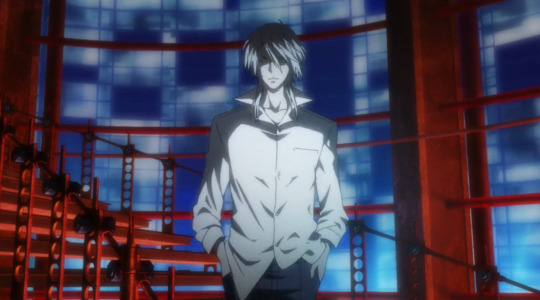
Maybe I will try to watch this on my own time but I will really need to get used to the violence, hahah. I had to shut it off a few times just from all of those awful scenes. Gosh, even recalling it makes my chest ache a little.
I might have to refrain from giving this one a rating, as I don't believe I've really seen enough of it.
0 notes
Text
Postmodernism in Eden of the East
Taking place during the “lost decade” of Japan’s 90s, Eden of the East articulates a rebuttal to professional individualism in Japanese society. I would argue that this anime imitates postmodernism, an era of literature that emerged in the late 20th century. It was most prevalently a criticism of modernism, an artistic movement caused by World Wars I and II and characterized by this collective social awakening: we could no longer rely on previously existing systems to survive. The economy was weak and individualistic notions smothered any sense of community and artistry. Modernism often has an industrialist spirit, for reality is plainly set out before us—no frills, embellishments, or care for aesthetics. Not only did modernism impact art, but also society itself, completely reframing work and family culture. Postmodernism is the antithesis of this—and primarily speaks against blunt realism and universal correctness, expressing that the traditional way of society has grown incompatible with the protean world.

Takizawa represents the generation of young people entering the workforce. The process of shushoku is filled with omnipresent inaccessibility to stable work as the older generations refuse to relinquish their positions. The idleness of labor initiation causes many young people to lose hope of attaining a successful career—these are the NEETs that Takizawa speaks of. His character symbolically stands for the new movement of workers—there must be a change in the system, and he sees Saki as a ‘mascot’ and an example of his movement.

Along with this revisionist angle, this anime is ornamented with some very interesting surrealist art direction and plot points. The abandoned mall setting of Takizawa’s home is an excellent manifestation of economic instability/collapse. Yet, Takizawa’s efforts to make it a home for himself and other NEETs show how there is a potential to repurpose failed systems. With even the competition he is forcibly involved in, Takizawa is determined to find the creator of the game, “Mr. Outside,” and force him to change his approach to “saving the country.”

In terms of narrative quality, I am ambivalent. First, I’m not sure why Saki was framed as a main character alongside Takizawa—that simply doesn’t make sense for the premise. Why would you not have the person involved in the death game as the sole protagonist? The beginning episodes were very solid, but I think the plot gets extremely convoluted and hard to follow as it progresses. There were some really great moments—but they were nebulously handled between plenty of unnecessary focus. I don’t think we particularly needed to see so much of Team Eden trying to figure out what Takizawa was doing while the viewer already knew. Wasted screentime.
5/10.
0 notes
Text
This Is How I Would Fix Sword Art Online
I will be quite frank—I do not like this anime. Long ago, I had watched it and disliked it and to this day my opinions have not faltered. Perhaps they have festered, even.
I want to be forgiving of this anime to say that the concept of Sword Art Online has potential. I think that is why disappointment stirs within me when I think of these character developments, plot points, and world-building details.

The virtual world of SAO and its entrapment of people’s consciousness is supposed to be a social experiment, yes? That is the show's strongest and most central aspect, yet we are robbed of any thoughtful analysis of it. When plots seem to hint at something deeper, we as the audience are only left in that shallow pool of wish fulfillment and fan service. Ah, so there are newer players that hold resentment toward the beta testers? Let’s antagonize them in favor of our edgy lone-wolf protagonist! It’s not as if that could be an interesting piece of commentary if focused on for longer than five minutes of screen time. Yui, the emotional support AI, has watched countless minds in torment longing for their loved ones? Yes, a quick montage should do the trick! I am bewildered that these topics simply get pushed to our periphery while our main characters simply vacation at some lake house.
This series would be worlds better if it were an anthology.
Consider—each episode takes the perspective of a new character trapped in the SAO virtual reality. Of course, it could still progress chronologically, and there can still be the undercurrent of a panoptic plot. However, a vast range of characters would much better fit the scope of the social experiment setup. We, dare I say, could actually see the experiment in action. There could be a number of different plots—from a more fleshed-out murder mystery to politically charged discourse between the most powerful guilds. We could see how the children trapped in this world struggled without their families and eventually formed ‘the orphanage’ that we see in later episodes. There could be more emphasis on players left in the wake of the more skilled fighters. There could be an episode dedicated to Yui in which we see her grapple with what it means to be an artificial being—to have empathy encoded within you with the inability to distinguish whether it is real or not. To be a walking contradiction.
What is reality? Such a question is not sufficiently considered within what I’ve watched. It is touched upon—Asuna says she is beginning to feel that all her life has been within the simulation. She and Kirito share in the reality of their connection to each other and the beauty of the world and we begin to see a glimpse of that rabbit hole. Why simply attribute meaning to the realm in which we call ‘real’ when just as well, lives can be fulfilling—or even more fulfilling—in an imitated world.

I think I will rate this anime 3.5/10.
3 notes
·
View notes
Text
No-Face
Spirited Away
Arguably one of the most iconic characters from the movie Spirited Away is the monstrous spirit, No Face, who enters the bathhouse one night after Chihiro opens the door for him. That very night he is seen slinking around the bathhouse where he learns how coveted money is among the workers. He lures a spirit using some illusory gold and devours him, gaining his voice! Come the next day, he astounds the bathhouse workers with his gold aplenty, taking expeditious control over the entire establishment. The frenzy that the workers devolve into encapsulates the tunnel vision of capitalist greed that can corrupt the workplace. The workers very literally bow down to “the rich man,” and serve him whatever it might take to earn more of his seemingly ceaseless mounds of riches.
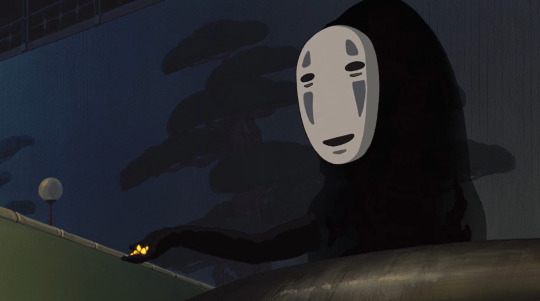

Notably, the gold itself is all but an illusion, turning to dirt before Yubaba’s eyes. This scene fortifies that things only have value when society endows them with it—even in the spirit world, money is only a construct of society.
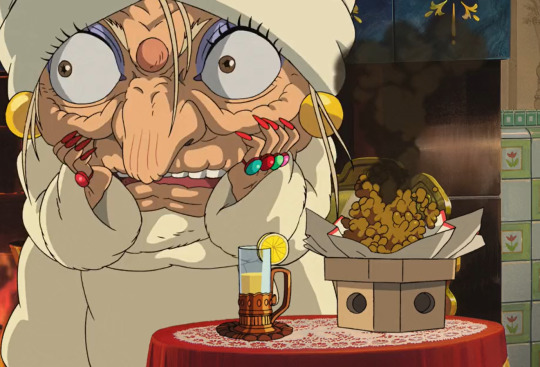
I have always loved this movie and will continue to do so. Ghibli films never fail to bring me to a state of awe—the music, the animation, the colors, and the story—all of it just brings me this beautiful joy. I always wonder where the ideas for these films sprout from. Spirited Away is such a unique piece of art with such whimsical imagery that it’s hard to imagine how anyone could have brought it to life—but it is so very alive and breathing. Oh goodness, what would I give to see that bathhouse in real life!

I also wanted to mention a little rabbit hole that I went down from this particular rewatch... Apparently, in Japan, there is a common Mandela effect of a ‘phantom ending’ that occurs after Chihiro and her parents leave in their car. Most people who claim to remember this ending seem to recall Chihiro arriving at her new house and exploring for a while. She wanders to her backyard and sees a river with a bridge that extends across it. When she crosses the bridge to view the river she sees an image of Haku across the way looking at her from within the trees. The movie turns to black after that.
It’s absurd to me how many people swear this ending to be real! I certainly don’t remember anything like that, but some claim it to be a deleted scene. Upon searching the internet, I was unable to find anything that proved this to be true. Just some interesting fandom material for you then! Hahah.
I adore this movie—it gets a 9/10.
3 notes
·
View notes
Text
A Place Further Than the Universe
There was a dream that I had of waking from a coma that had sent me forward a whole year of my life. It was the eve of my sophomore year in high school. The cognizance that my time in school was transient and brief clung to my mind the entire day. Right beside it was the dread that I wouldn’t do enough to make it memorable!

In A Place Further Than the Universe, our main character, Tamari, comes to fear a similar notion as I did and begins her search for something to ‘make the most of her youth.’ This leads her down a path to Antarctica with a group of friends she had acquired along the way.
There were some lovely moments between this cast of characters and it solidified the power that a slice-of-life anime can have. The casual nature of how events are structured simulates the feeling that real life can often have—a disorderly amalgam of conflict, joy, sadness, and seasickness.
I wanted to talk in more detail about episode 10, as I found Yuzuki’s ‘friendship contract’ an interesting manifestation of capitalism in personal relationships. Capitalism is often characterized by the ‘rat race’ — that perennial cycle of success and failure that inevitably involves rivaling others. Yuzuki’s life is encompassed by such constant competition and she neglects her social life severely. But when at last she finds friendships she wants to hold onto, she contends her fear of loss in the only way she knows how: with business. We learn that Yuzuki’s enduring lack of personal friendships stunted the development of an intuitive understanding of relationships and emotion. I appreciated the way that Yuzuki’s friends gently explained to her how they thought friendships were supposed to be instead of arguing with her. :)

It really reveals how capitalism permeates all aspects of life. The symbolism of the Arctic—a place where society's will hardly reaches—is a perfect place to make such criticisms. How inspiring it is to see this group of Arctic explorers function as a team rather than a pyramid of power.
I enjoyed this anime a good amount and rate it 7/10 stars. ᨒ✧
6 notes
·
View notes
